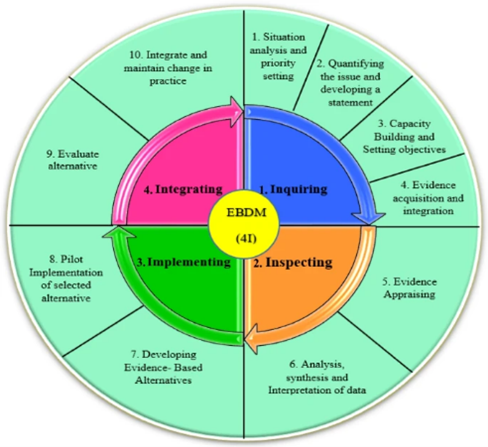Evidence Based Decision Making: A Pillar of Optimal Performance
Decision making is at the heart of leadership, management, and performance. I write about mindful conflict and expectations management, and the decision making that underlies both. Last month the article on the use of the Evaporating Cloud technique addressed the power of collaborating to face conflict to identify goals, wants, and needs.
This article focuses on making decisions based on evidence and rational thinking as opposed to unfounded opinions and emotions. While feelings are important, they are often without a sound basis in reality. Acting upon them without investigating evidence and alternatives is foolish. Not considering the feelings is equally unwise.
“When somebody on staff asks what we should do to
address a problem, the first questions I now ask are
‘What does the research say? What is the evidence base?
What information can we gather to determine if it will
fit in different contexts?’ It’s become a way of life.”
– Jim Hmurovich, BA, MS Ed, President & CEO, Prevent Child Abuse America
Decisions
Here is a simple example to bring out the practical nature evidence based decision making:
In an apartment building an occupant, Ms. H, objected to the practice of leaving a building provided package cart in the elevator for the next elevator rider to return to the lobby.
She felt that the “rude behavior of some made it impossible for others to use our very limited elevators.”
Taking a rational look at the issue, it seems that if the person who borrowed the cart took it down in the elevator there would be one less spot on the elevator for other riders. Further investigation may uncover that Ms. H. doesn’t like to or isn’t able to get on an elevator with a cart. If that is the case, adding the cart’s borrower to the trip will do her no good.
Ms. H failed to consider the facts. Her emotions and biases drove her demand. She was reactive. Imagine if she was good at convincing others without providing any foundation in fact and logic, and the decision makers just threw up their hands and created a rule that “borrowers or designated alternatives must return the carts themselves.”
This is a simple example. But how often are projects hampered by reactive behavior? Instead step back to consider evidence and apply analytical thinking along with emotional and social intelligence.
The decision gets more serious if it was about whether to purchase a product or create one. Ms. H, now in her capacity as senior executive and project sponsor, insists that buying a product is the way to go. She was convinced that development was too risky and expensive. She had been burned when in an earlier project a decision to build vs. buy led to a project with costly overruns. She was sold by product vendors and external consultants on the idea that the products were easily customized to the unique needs of Ms. H’s organization. And that the organization would be better off changing procedures to accommodate the products.
An analytical review of research, the experiences of others, and a clear sense of the nature of the customization required would uncover the risks and expense of adapting to or customizing a product rather than creating one’s own to fit special needs.
The decision could go either way. The point is to combine analysis and intuition to best decisions. “Good” decisions are informed decisions that combine information (facts, feelings, interpretations and opinions, etc.) from multiple perspectives. Good decisions are more likely to successfully solve the problem at hand than decisions made based on limited information.
Advertisement
[widget id=”custom_html-68″]
Evidence Based Decision Making
Evidence Based Decision-Making (EBDM) leads to informed decisions. “Evidence Based Decision-Making is a process for making decisions about a program, practice, or policy that is grounded in the best available research evidence and informed by experiential evidence from the field and relevant contextual evidence.”[1] Not only does it result in optimal decisions, but EBDM also cultivates collaborative action and cuts through unnecessary conflict.
Evidence Based Decision Making (EBDM) is described as a 4-part process with 10 steps and 47 sub-steps. The model is shown in Figure 1:[2]

Figure 1: The EDBM
Don’t worry, we won’t go into the 10 steps and 47 sub-steps. Though, having a detailed model is useful for training and to promote collective understanding of required tasks, roles, and skills. See the referenced source for the full model.
But let’s be realistic, getting decision makers and stakeholders like Ms. H to buy into a super-analytical process with 47 steps is virtually impossible. Well maybe not impossible, but requiring a mindset transformation, and that takes time.
The successful decision maker understands the process and adapts it to the current situation. She avoids analysis paralysis and understands that collaboration among the decision makers is as important as the weighting and scoring of facts and feelings. Based on inquiry the rest of the process is customized to fit the personalities, cultural influences, need for speed, availability of evidence and the capacity of the decision makers.
Evidence
EBDM means making decisions using four sources[3]
- the best available scientific evidence – research studies, experiments, journal articles, etc.
- organizational evidence – business data, including financial reports and performance, studies, project journals and history, organizational culture, etc.
- experiential evidence – the collective experience of the decision-makers and outside experts
- stakeholder evidence – stakeholder expectations, feelings, beliefs, biases, wants, needs, and values.
On the surface all four types of evidence seem objective, where “Objective evidence is evidence that is not subject to bias and is quantifiable and able to be independently confirmed and verified by using analytical or other tools. Simply put, objective evidence is based on facts and is the kind of evidence that can be independently examined, evaluated, and verified.”[4]
But go a little deeper and you find that there can be subjectivity in each. For example, there are often many ways to interpret scientific data. The same data can be used to justify any number of opinions, which when written up in a journal article can give the impression of being objective.
Subjective evidence is based on individual interpretations and opinions. It cannot be independently verified. When subjective evidence is valued and evaluated in concert with objective evidence and the multiple subjective experiences, it is often what leads to the most effective solutions. Evidence based decision making makes subjective evidence a valued part of the process.
Applying EBDM
EBDM is a process to uncover convincing evidence using objective analysis. Like all approaches to decision making, it is a quest for greater certainty about the outcome of a decision. Use it to go beyond both decision-by-the-numbers and decision-by-feelings. Objectivity and subjectivity are facts of life in any complex decision making, do not ignore either. To be objective a decision maker must acknowledge the presence of subjectivity and incorporate it into the decision making.
If you are fortunate enough to be making decisions optimally, resolving conflicts, setting expectations, experiencing great outcomes, just keep doing what you are doing. If there is room for improvement, bring EBDM into your work, whether it is you alone or the team. Raise it as a topic as you work to continuously improve performance guided by informed decisions.





